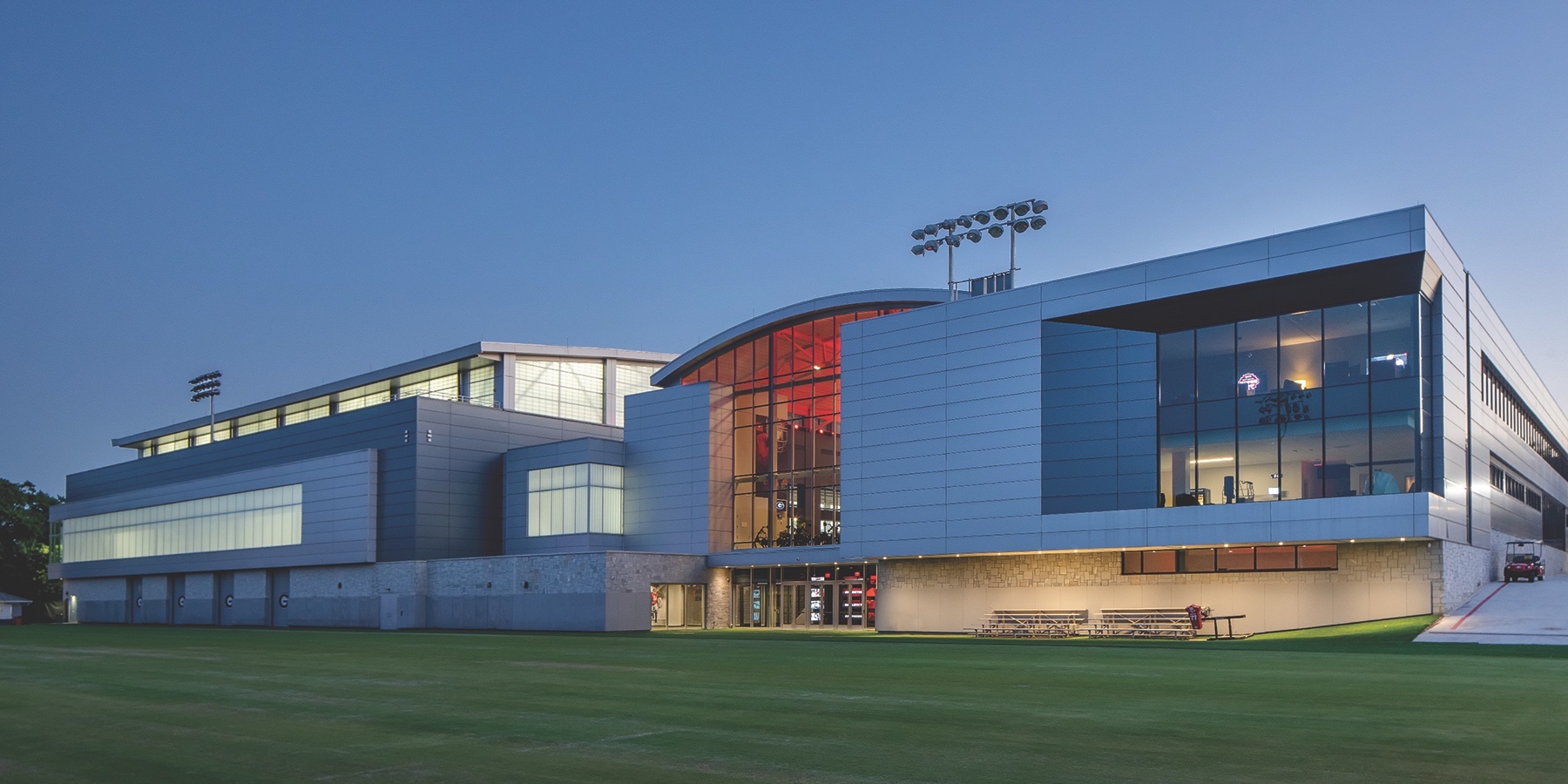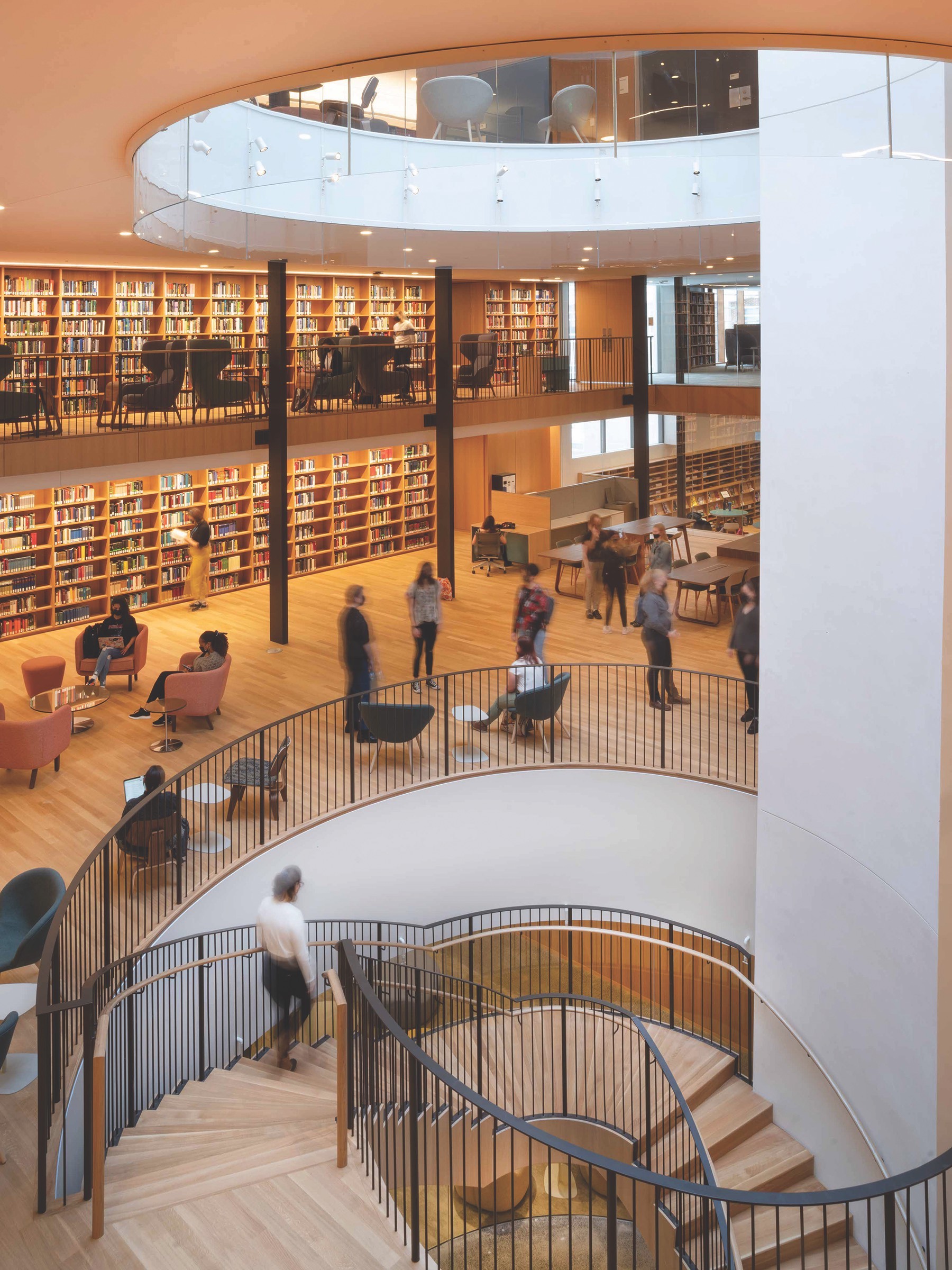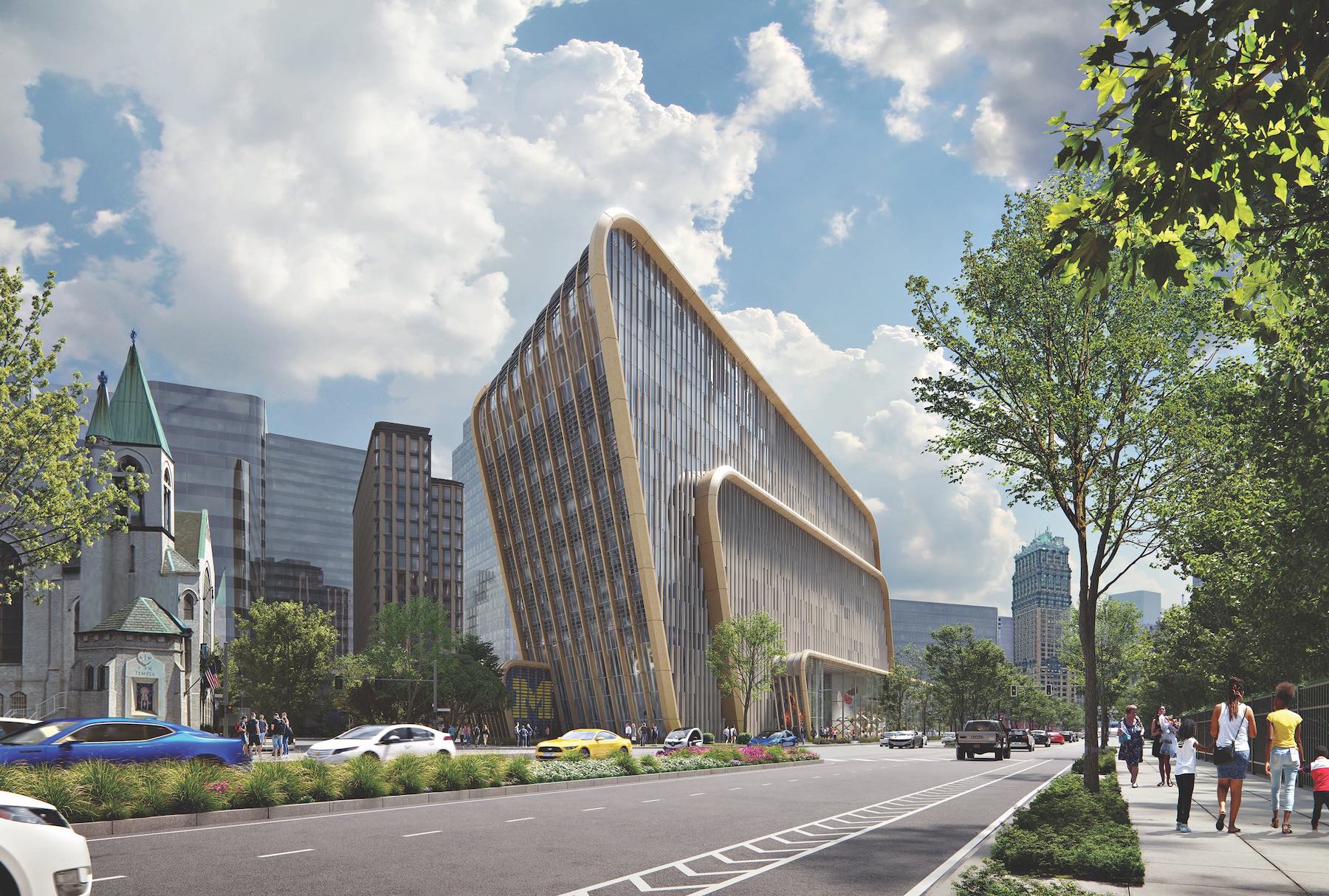Sustainability is a high priority for Des Moines University’s new 88-acre campus for health sciences education in West Des Moines, Iowa, which will include 350,000 sf of spaces for classrooms, labs, a fitness center, admin offices, and parking.
IMEG Corp. is providing engineering designs and services for this $105 million project, which is scheduled for completion next year. (RDG Planning & Design and Turner Construction are on the building team.) The designs for the campus include a 700-well geothermal system for heating and cooling. The campus’s central utility plant will include a 1.0 mW generator with an option to add a second plant. Water-to-water heat pumps connected to the geothermal well field will provide 1,300 tons of cooling and 10,300 MBH (1,000 Btu/h) of heating.
Sustainability and design flexibility are what higher education clients are seeking consistently, according to the dozen AEC Giants contacted for this article. “University campuses across North America are commissioning new construction projects designed to make existing buildings and energy systems more sustainable, and are building new flexible learning space that bridge the gap between remote and in-person learning,” say Patrick McCafferty, Arup’s Education Business Leader–Americas East region, and Matt Humphries, Education Business Leader in Canada region.
Humphries points specifically to the University of Toronto at Mississauga’s Centre for Medicinal Chemistry, which will be the most energy efficient lab ever constructed in ASHRAE Climate Zone 5. The university expects the building to achieve a 60% reduction in energy use compared to ASHRAE 90.1.
McCafferty singles out three recent projects—the University of Virginia’s Data Science Center, Northeastern University’s Interdisciplinary Science and Engineering Complex, and Harvard’s Treehouse Conference and Convening space—as examples that meet demand for flexible yet complex spaces. He adds, too, that every higher ed project now “aims to reduce the overall carbon footprint of campuses.”
Both Buro Happold and RMF Engineering had a hand in Harvard University’s latest campus in Allston, Mass. RMF was involved in the installation of a 54,000-sf district energy facility that provides chilled water, low-temperature hot water, and electrical power to the campus’s buildings. The facility includes a heat-recovery chiller and a 1.34-million-gallon thermal energy storage tank. Buro Happold provided integrated structural and geotechnical engineering services for the campus’s 544,000-sf, eight-story LEED-Platinum certified Science and Engineering complex that offers an adaptable, innovative environment “while showcasing sustainability,” says Susan Sachs, a Partner with Buro Happold.

That firm’s higher ed consultancy, brightspot, was the planner for Smith College’s Neilson Library in Northampton, Mass., which the college touts as “one of the most sustainable libraries in the U.S.” It includes a central oculus for daylighting, a window-to-wall ratio optimized for high performance, sun louvers, and double-pane glass. It uses recycled materials, and its interior is red-list chemical free.
Libraries accounted for 12 of brightspot’s 32 higher ed sector projects in the 12 months ending June 2022. “A lot of libraries are planning for their post-pandemic futures,” says Buro Happold Marketing Manager Sinead O’Connor.
Planning sets stage for robust activity
In collaboration with the Society for College and University Planning (SCUP), brightspot recently released a Campus Facilities Inventory Report, which found that 84% of institutions planned to update or adapt existing facilities over the next year, 80% planned to make major updates to campus infrastructure, and 88% intended to update meeting room technologies for more virtual learning engagements.
Project demand appears to be cutting across building types and learning disciplines. And for most of the AEC firms contacted for this article, science, engineering, and health sciences comprise the bulk of their higher ed new construction or renovation.
The SmithGroup-designed, 175,210-sf Anne Arundel Community College Health and Life Science Building now provides a shared home for the school’s life sciences and biology programs. Its features include Sim-City, medical simulation rooms with operable partitions to allow group events; a white-box theatre with projection and whiteboards that can function as a classroom; a 360-degree simulation theater; and a biology super lab with motorized partitions. The LEED Gold building also has a 160-seat lecture hall, a greenhouse, classrooms and computer labs, study and meeting rooms, and offices.
“Resilience, flexibility, and adaptability are fundamental guiding principles” for designing academic spaces, says Chris Purdy, AIA, LEED AP, SmithGroup’s Vice President–Higher Ed Practice Director. The firm has been seeing more demand for projects with health science programming that addresses regional needs for increased care providers and community health, such as physical therapy.
In May, Colorado State University opened the 80,000-sf Nutrien Agricultural Sciences building that centers the school’s College of Agricultural Sciences at the heart of its campus. Designed by CannonDesign, the Nutrien building features labs and studios on its upper floors, a 180-seat in-the-round auditorium, a student-focused mall that creates storefronts for the building’s programming, and an Innovation Gym for collaboration.
Building college facilities for a return to normal
DPR Construction has seen a steady increase in capital planning activities for renovations, modernizations, and new construction, says Greg Fraikor, the firm’s Higher Education Core Market Leader. “The continued demand for general classrooms, sports facilities, and student housing is being driven by the momentum of students likely returning to a more ‘normal’ on-campus community lifestyle,” he explains. One recent example is the 160,000-sf addition to and renovation of the University of Georgia’s Butts-Mehre Heritage Hall, which Fraikor claims enhances the student-athlete experience as one of the largest sports medicine and strength and conditioning facilities in the country for a Division 1 team.

Athletics and kinesiology, along with STEM, housing, and renovations are the kinds of higher ed projects that HMC Architects has been engaging lately. “Academic buildings and affordable housing are the priorities in California,” says Sean R. Rosebrugh, AIA, LEED BD+C, HMC’s Principal in Charge–Higher Education. At California State University, Fullerton, one such project is expanding that campus’s housing options by demolishing older buildings, eliminating a parking lot, and extending the campus footprint. The new $120 million, six-story building with 600 beds, which HMC designed and Sundt is constructing, is organized so that its three wings, while connected as a cohesive “community,” can also operate autonomously, depending on resident or conference needs. The building is scheduled for completion in August.
The trend toward student “normalcy” might also explain the demand on some campuses for new performing arts centers. At Brown University in Rhode Island, Shawmut Design and Construction has been completing the 94,000-sf Lindemann Performing Arts Center, which is set to open next year and will anchor a future campus arts district, says Ron Simoneau, Shawmut’s Executive Vice President of Education.
SmithGroup is also seeing demand from universities and colleges for multicultural projects that address inclusion, says Purdy. These include a Multicultural Center at Michigan State University, and the College of DuPage’s Student Success Center encompassing a multicultural space.
Demand for higher education building construction still ambivalent
SmithGroup’s higher ed practice enjoyed an increase in business last year, “with students at the core of institutions’ decision-making more than ever before,” says Purdy.
“Coming out of the pandemic, campuses are in a period of reflection, to be prepared for the future,” observes John Holbert, IMEG Corp.’s National Director of Education. Consequently, his firm has been receiving “a tremendous number of proposals” from institutions across the U.S., with focuses on academic health and industrial technology. “Right now, the balance is getting the supply chain and budget to align with designs,” says Holbert.
For some AEC firms, though, demand from the university sector has been mixed. Over the past year, HMC Architects saw a decrease in demand, possibly due to reduced enrollments and lack of reliable funding from California, suggests Ken Salyer, AIA, HMC’s Principal and Higher Ed Practice Leader. LF Driscoll, the construction management firm, also has experienced a slowdown in RFPs across the higher ed sector, and some projects put on hold “indefinitely,” says Trish Mitchell, the firm’s Director of Business Development.
Conversely, Buro Happold saw “a welcomed increase” in demand, says Sachs. And brightspot had around 10 more university projects between June 2021 and June 2022, compared to the previous 12-month period, says O’Connor.
During the past year, architecture firm Kohn Pedersen Fox saw a slight uptick in higher ed project demand, with a “continued focus” on research and innovation districts, says Jill Lerner, FAIA, Principal.
One of her firm’s latest endeavors is the Detroit Center for Innovation, to be located on four acres in The District Detroit, a mixed-use sports and entertainment district between the Motor City’s downtown and midtown. With groundbreaking scheduled for 2023, this $250 million innovation project—whose clients include the University of Michigan and the developers Related Companies and Olympia Development—will feature 200,000 sf of research and graduate education space for UM students in mobility, AI, data science, entrepreneurship, cybersecurity, and financial technology. The initial phase will also include incubator and startup services, residential units, a hotel/conference center, and event space.
Related Stories
| Nov 3, 2010
Recreation center targets student health, earns LEED Platinum
Not only is the student recreation center at the University of Arizona, Tucson, the hub of student life but its new 54,000-sf addition is also super-green, having recently attained LEED Platinum certification.
| Nov 3, 2010
Designs complete for new elementary school
SchenkelShultz has completed design of the new 101,270-sf elementary Highlands Elementary School, as well as designs for three existing buildings that will be renovated, in Kissimmee, Fla. The school will provide 48 classrooms for 920 students, a cafeteria, a media center, and a music/art suite with outdoor patio. Three facilities scheduled for renovations total 19,459 sf and include an eight-classroom building that will be used as an exceptional student education center, a older media center that will be used as a multipurpose building, and another building that will be reworked as a parent center, with two meeting rooms for community use. W.G. Mills/Ranger is serving as CM for the $15.1 million project.
| Nov 3, 2010
Virginia biofuel research center moving along
The Sustainable Energy Technology Center has broken ground in October on the Danville, Va., campus of the Institute for Advanced Learning and Research. The 25,000-sf facility will be used to develop enhanced bio-based fuels, and will house research laboratories, support labs, graduate student research space, and faculty offices. Rainwater harvesting, a vegetated roof, low-VOC and recycled materials, photovoltaic panels, high-efficiency plumbing fixtures and water-saving systems, and LED light fixtures will be deployed. Dewberry served as lead architect, with Lord Aeck & Sargent serving as laboratory designer and sustainability consultant. Perigon Engineering consulted on high-bay process labs. New Atlantic Contracting is building the facility.
| Nov 3, 2010
Dining center cooks up LEED Platinum rating
Students at Bowling Green State University in Ohio will be eating in a new LEED Platinum multiuse dining center next fall. The 30,000-sf McDonald Dining Center will have a 700-seat main dining room, a quick-service restaurant, retail space, and multiple areas for students to gather inside and out, including a fire pit and several patios—one of them on the rooftop.
| Nov 2, 2010
Cypress Siding Helps Nature Center Look its Part
The Trinity River Audubon Center, which sits within a 6,000-acre forest just outside Dallas, utilizes sustainable materials that help the $12.5 million nature center fit its wooded setting and put it on a path to earning LEED Gold.
| Oct 27, 2010
Grid-neutral education complex to serve students, community
MVE Institutional designed the Downtown Educational Complex in Oakland, Calif., to serve as an educational facility, community center, and grid-neutral green building. The 123,000-sf complex, now under construction on a 5.5-acre site in the city’s Lake Merritt neighborhood, will be built in two phases, the first expected to be completed in spring 2012 and the second in fall 2014.
| Oct 13, 2010
Editorial
The AEC industry shares a widespread obsession with the new. New is fresh. New is youthful. New is cool. But “old” or “slightly used” can be financially profitable and professionally rewarding, too.
| Oct 13, 2010
Thought Leader
Sundra L. Ryce, President and CEO of SLR Contracting & Service Company, Buffalo, N.Y., talks about her firm’s success in new construction, renovation, CM, and design-build projects for the Navy, Air Force, and Buffalo Public Schools.
| Oct 13, 2010
Campus building gives students a taste of the business world
William R. Hough Hall is the new home of the Warrington College of Business Administration at the University of Florida in Gainesville. The $17.6 million, 70,000-sf building gives students access to the latest technology, including a lab that simulates the stock exchange.
| Oct 13, 2010
Science building supports enrollment increases
The new Kluge-Moses Science Building at Piedmont Virginia Community College, in Charlottesville, is part of a campus update designed and managed by the Lukmire Partnership. The 34,000-sf building is designed to be both a focal point of the college and a recruitment mechanism to get more students enrolling in healthcare programs.
















